Banham avec Ballard
On style and violence
Mark Dorrian
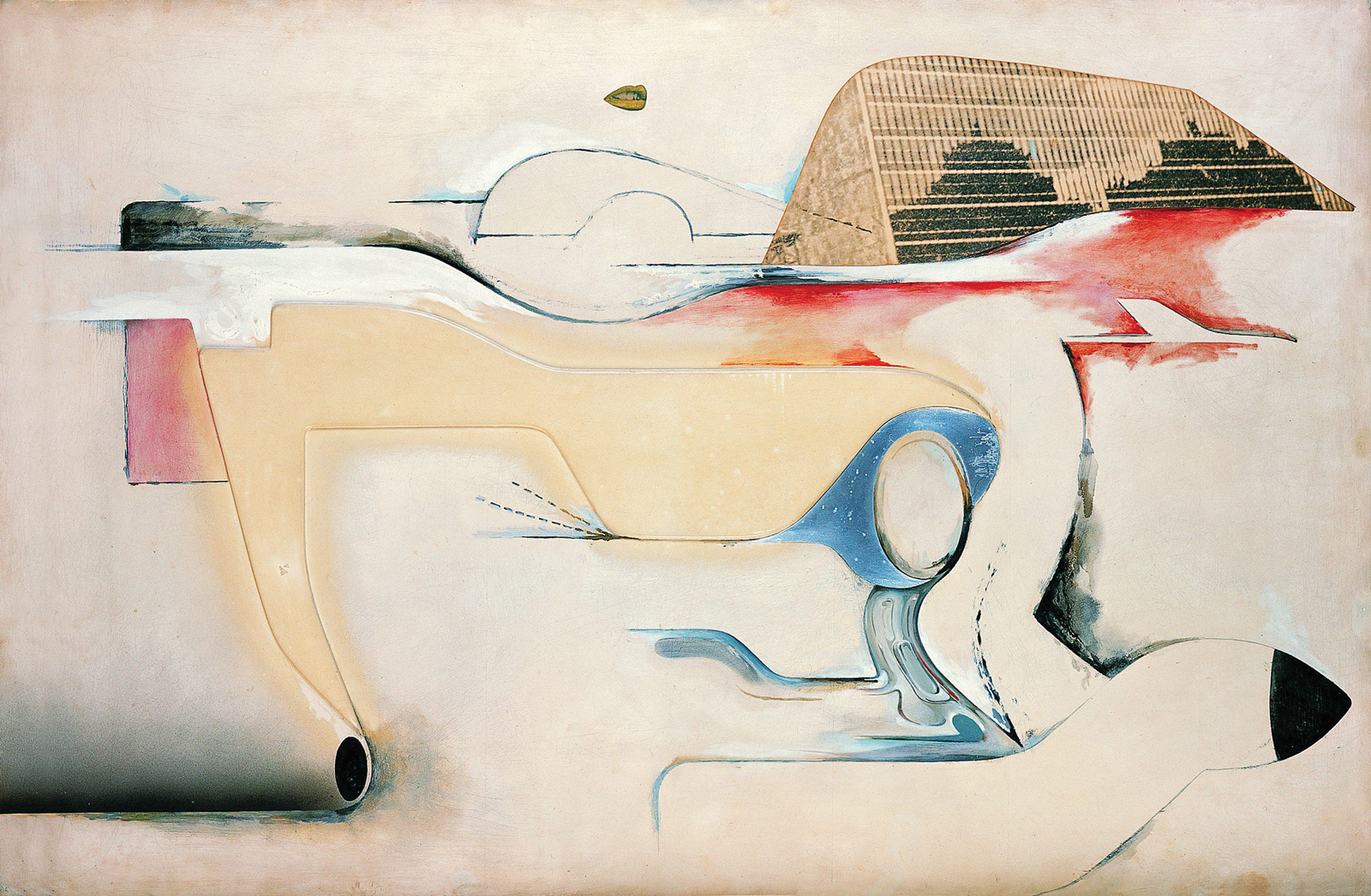
In January 1961, the eminent architectural historian Nikolaus Pevsner gave an address at the London headquarters of the Royal Institute of British Architects during which he reflected upon troubling developments that had become apparent within architectural culture over the previous decade. A month later, he spread the word to a broader public audience through two radio broadcasts for the BBC, one of which was aired on the corporation’s German service.[1]
At first sight, Pevsner’s invective seems straightforwardly addressed to what he called the “return of historicism”—the return of historical reference—in architecture. But on closer inspection, it becomes clear that this was driven by distaste for what might be described as the emergent conditions of affect in the architecture of the period. Although Pevsner’s talk didn’t extend beyond architecture, it might best be understood as a discipline-specific complaint symptomatic of larger shifts and contestations stirred by the expanding media forms of postwar consumer society. One way of characterizing what disturbed Pevsner, and this is closely linked to the changed conditions of affect, is the lapse of “style” into “styling”—that is, the displacement of epochally determined form by mutable, transient, and libidinally invested morphologies seemingly unrelated to any deep underlying necessity. Perhaps the most prominent celebrant of this happened to be Reyner Banham, Pevsner’s former doctoral student and the first convener of the Independent Group at the Institute of Contemporary Arts (ICA), who was in the lecture hall as one of the official respondents to Pevsner’s talk. We will come back to Banham and the Independent Group, but let’s first look more closely at what Pevsner said about the “return of historicism.”
It was, he warned, a return with a difference, for while his audience might associate historicism with the classical or the gothic, the referents of previous revivals, now the allusions made were to “much more recent styles” and the work might thus appear not to be a kind of historicism at all. Although in his following radio talks Pevsner would describe this tendency as “anti-rational” and hence “anti-functionalist,” in his lecture it was clear that what he really regretted was the disappearance of the restraining image of functionality. He did not suppose that the buildings he was criticizing did not function well—his difficulty was rather that they did not look as if they did. And while this line of argument might seem to threaten the functionalism/historicism opposition insofar as it implied that functionalism was no less symbolically motivated than historicism, Pevsner was careful to steer his listeners away from that awkward conclusion and toward the unstated but implicit regret that structured his discourse—the loss of a principle of decorum, of the correct thing occupying its correct place in both space and time.
For Pevsner, the outbreak in the 1950s of misconceived projects was directly related to mutations in the work of modern masters such as Le Corbusier, who had started to perform, as the historian put it, “funny turns.”[2] The work he chastised sought to emulate these, but also encouraged its proponents to ransack recent history in search of comparable forms—and hence the charge of “new historicism.”[3] Although Le Corbusier’s chapel of Notre Dame du Haut at Ronchamp (1950–1955) might have been the most prominent funny turn, it in fact turned out to be one that Pevsner could accept—in the case of a pilgrimage chapel, he deemed states of heightened emotion appropriate. What he could not countenance, however, was the extension of this, whereby architecture became an instrument of indiscriminate and generalized public excitation and intensified affect. As he wrote, “When it comes to an administrative building, such as [Le Corbusier’s] Chandigarh Secretariat, then I would speak of ‘outrageous stimulation.’”[4]
As I’ve already suggested, although Pevsner’s criticism was addressed to architecture, it is a lament that takes place within a more expansive context of cultural and economic transformation. Certainly, “outrageous stimulation” can well stand as the default condition of the emergent image-world belonging to what has been called the second machine age and first pop age, most obviously with regard to the ever-intensifying penetration and saturation of society by advertisements, those lubricants of commodities whose mode of operation was rather precisely registered in Pevsner’s phrase.[5] Such images and their effects had, during the decade upon which Pevsner was looking back, much preoccupied the Independent Group at London’s ICA, whose members included figures such as the artists Eduardo Paolozzi and Richard Hamilton, the critic and curator Lawrence Alloway, the architects Alison and Peter Smithson—and, of course, Reyner Banham.
In 1955, the same year that the ICA presented Richard Hamilton’s “Man, Machine and Motion” exhibition, Banham had given two talks there on US automobile design and advertising, the first to his Independent Group compatriots and the second as a public lecture.[6] Very much a paean to the art of the body stylist, his reflections were published the same year in his influential article “Vehicles of Desire.” Considering the American automobile from the perspective of austere postwar Britain, Banham’s essay addressed the most emblematic and economically pivotal consumer object of the period, “a vehicle of popular desire and a dream that money can just about buy.”[7] It eulogized the dynamic transformations of US car styling under highly competitive market conditions, leveraging this against architects’ pretentions to determine universal and timeless standards in design. To the singular, transcendent object of elite cultural arbitrage, Banham opposed the styled, fast-moving object of consumer society, “a thick ripe stream of loaded symbols”—the “repertoire of hooded headlamps, bumper-bombs ... incipient tail fins ... protruding exhaust pipes, cineramic wind-screens,” but also “the profiling of wheel-arches, the humping of mudguards, the angling of roof posts,” as well as “the grouping of the main masses, the quality of the main curves of the panels,” etc.[8]
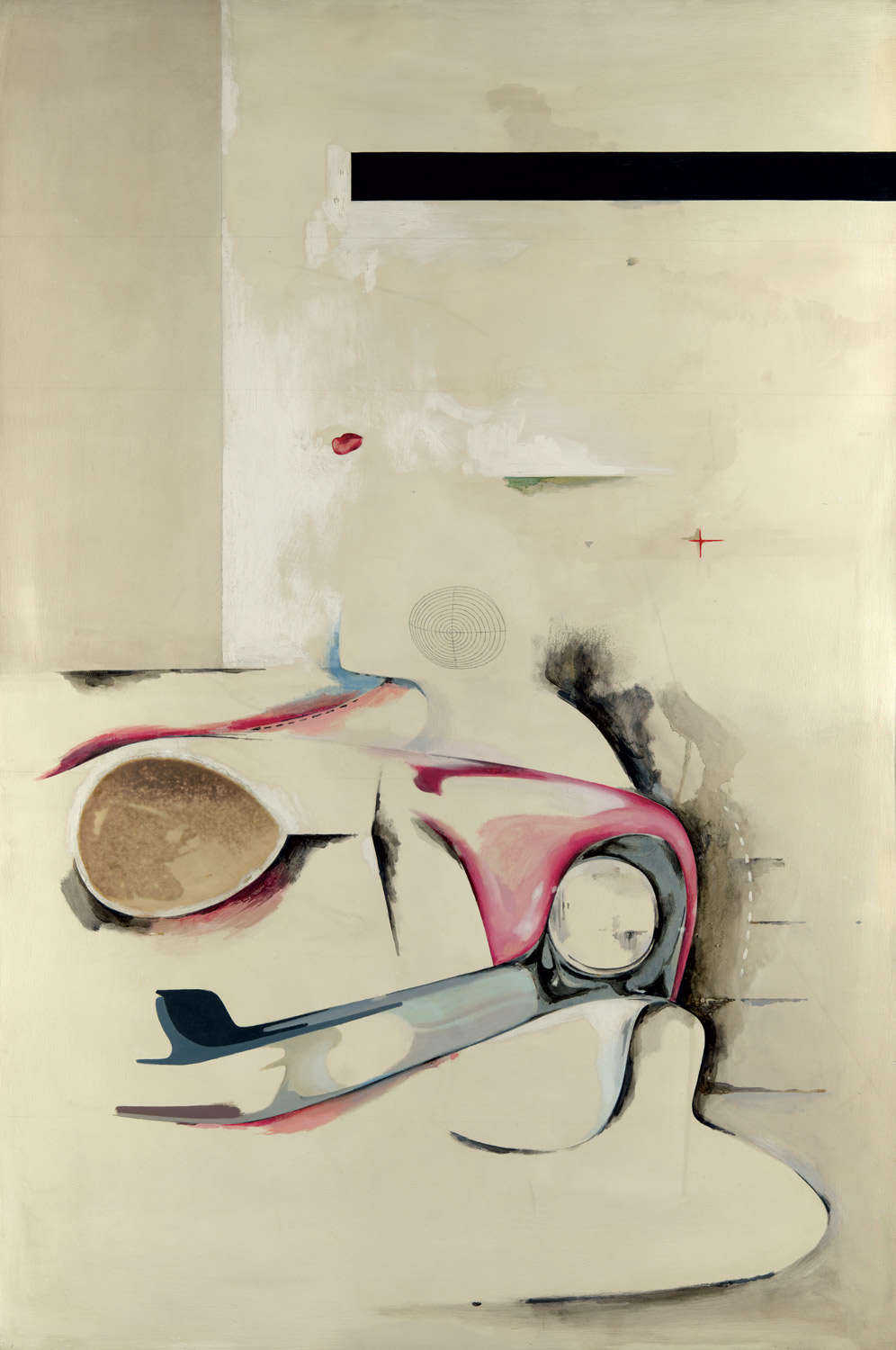
Banham’s reflections on car design had a profound impact, by his own account, on Richard Hamilton. Their influence is, to take one example, clearly evident in the latter’s lecture “Persuading Image,” which discussed obsolescence as a wealth-producing driver of industrial production. Where Banham had characterized the operation of the automobile industry as “emotional-engineering-by-public-consent,” Hamilton went further, advocating the use of social science research to intensify consumption. “Industry needs greater control of the consumer,” he wrote, and “propaganda techniques could be exploited more systematically by industry to mould the consumer to its own ends.”[9] In 1957 and 1958, Hamilton had produced two works, Hommage à Chrysler Corp. and Hers Is a Lush Situation, respectively, that drew directly on automobile advertising, the second of which derived its title from a US magazine article that Banham had discussed in his essay. In these paintings, styling—the body styling of both car and female model, which were typically coupled in advertisements—becomes the precondition for a merging of the two. This “interplay of fleshy plastic, and smooth, fleshier metal,” as Hamilton would describe it in relation to a later work, was dependent to a large degree upon the surface effects of product and picture, a zone in which the hypersmooth surfaces of chrome and of spray car paint merged with those of the defectless airbrushed image.[10]
Describing the development of these paintings, Hal Foster has argued that they move from a situation in which there is an analogical relation between the parts of the female body and the commodity-object to one of an “actual commingling”—spatial blending within which the line of the car is implicated, and across which the eye slides between points of intensity and attachment.[11] (Fetishistic “charged details,” he calls them: lips, automobile elements of the sort we have seen ecstatically enumerated by Banham, etc.) Here, accounts of desire in terms of metonymic slippage meet with the sexualized commodity. As Foster writes, Hamilton “recognizes that all these forms are now reworked in the image of a general fetishism (commodity, sexual, and semiotic), and he moves to exploit this new order. ... Painting allows for the requisite mixing not only of charged details with blended anatomies but also of the optical jumpiness of the subject with the erotic smoothness of the object; it is this unresolved combination that makes his early paintings both pull apart and hold together.”[12]
The importance of the Independent Group for the author J. G. Ballard has often been attested.[13] He himself spoke of the impact of their exhibits at the seminal show This Is Tomorrow, held at the Whitechapel Gallery in London in 1956: “To see my experience of the real world being commented upon, played back to me with all kinds of ironic gestures, that was tremendously exciting.”[14] Deeply preoccupied with the psychological effects of what he called the new media and communications landscape, Ballard would experiment with a series of speculative works modeled on advertising. In 1958, while working as a sub-editor at the journal Chemistry & Industry, he produced a series of proto-cut-up spreads that came to be titled “Project for a New Novel.” Using clipped text and notational graphics, these were intended to be affixed to roadside billboards and read at speed from passing cars. A decade later, he would produce a number of full-page “advertisements for ideas” that appeared in magazines like Ambit and New Worlds, to which he was a regular contributor. His hope to place them in mainstream magazines such as Vogue ran aground when costs proved prohibitive.
When Michael Moorcock took over as editor of the British science fiction magazine New Worlds in 1964, his first editorial—“A New Literature for the Space Age,” a title apparently supplied by Ballard—took the form of an homage to William Burroughs, whose techniques Moorcock acclaimed as “science fiction in themselves.”[15] “The desperate and cynical mood” of Burroughs’s work, he declared, “mirrors exactly the mood of our ad-saturated, Bomb-dominated, power-corrupted times.”[16] The issue concluded with a review by Ballard of Burroughs’s novels, which hailed them as “the first authentic mythology of the age of Cape Canaveral, Hiroshima and Belsen ... a progress report from an inmate in the cosmic madhouse.”[17]
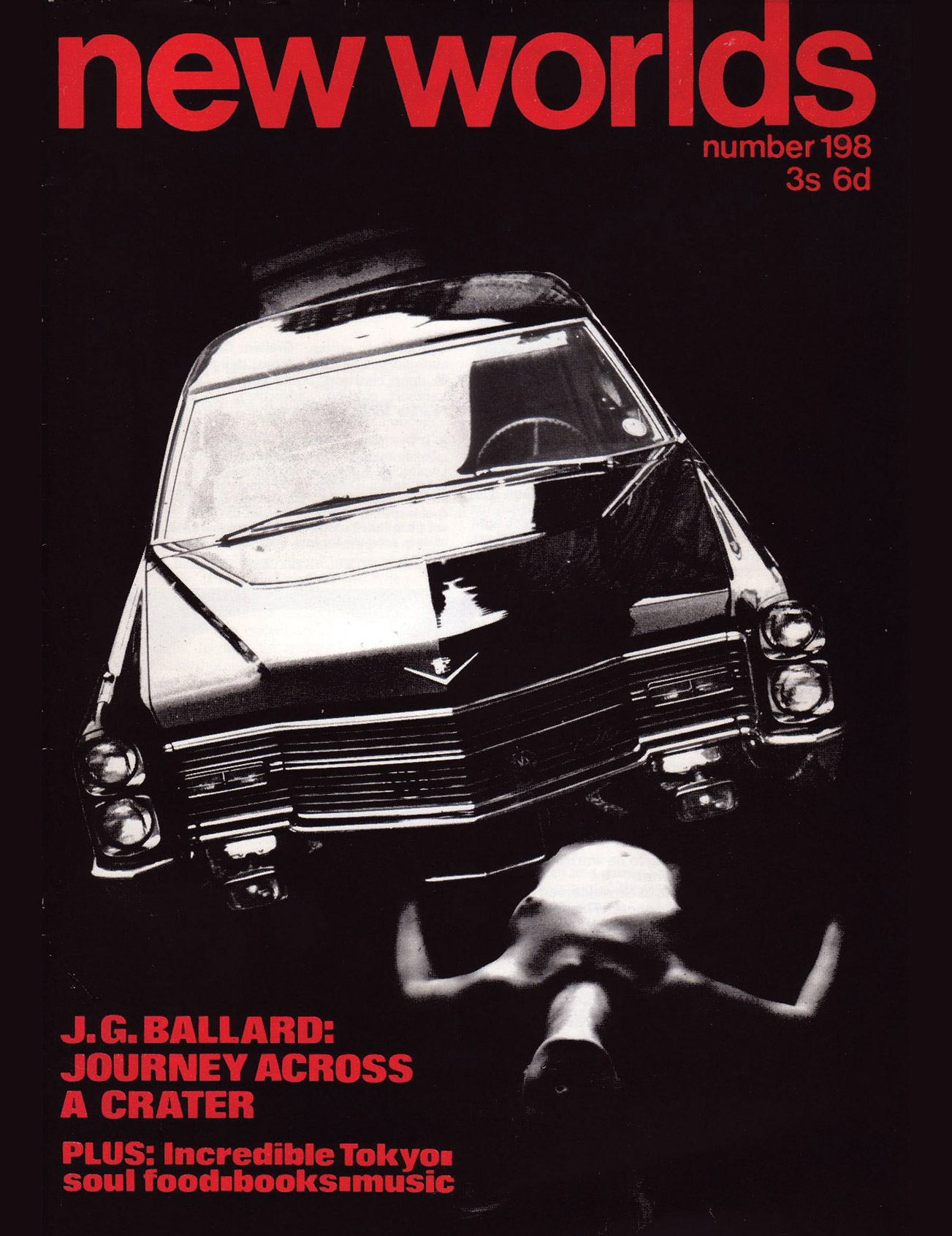
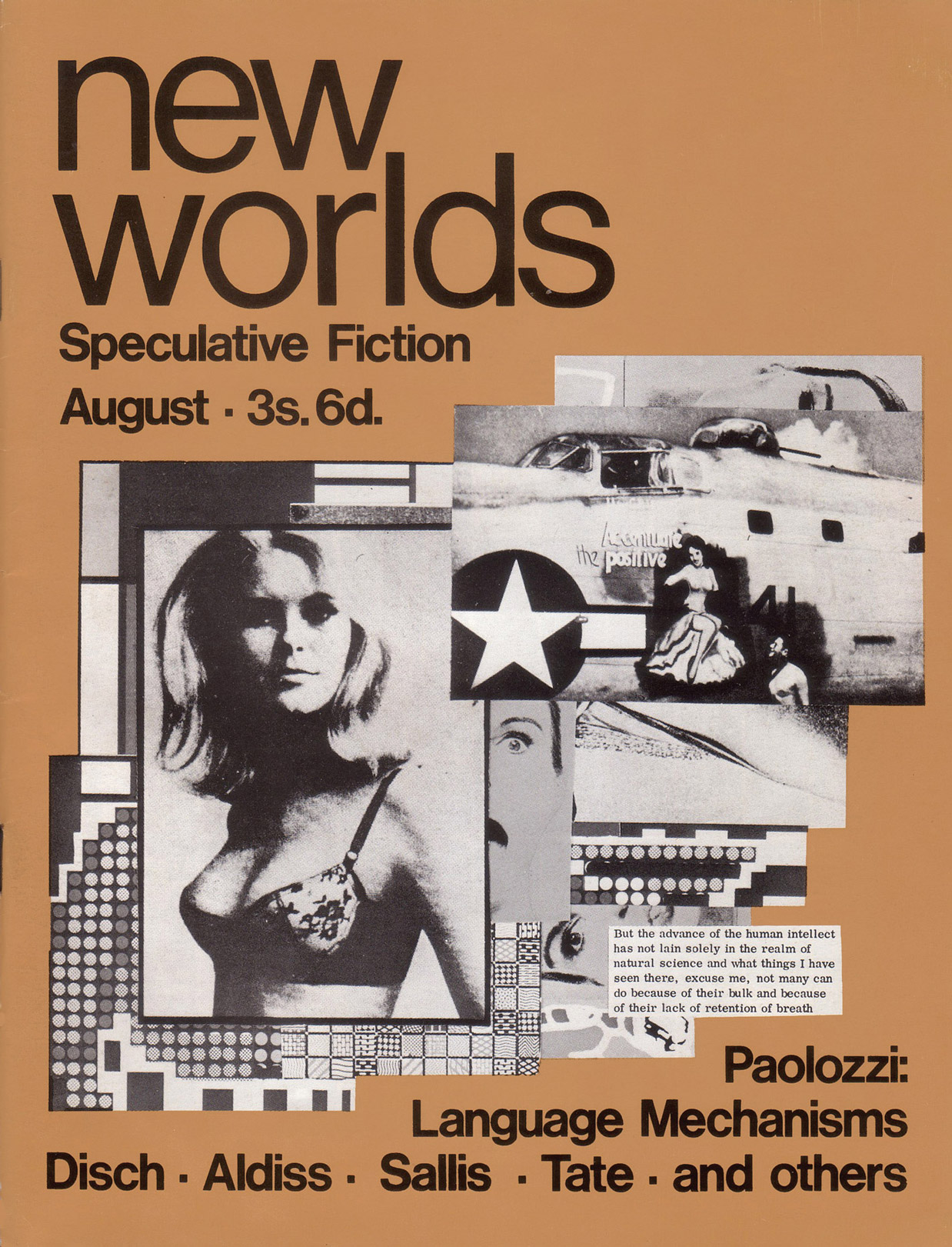
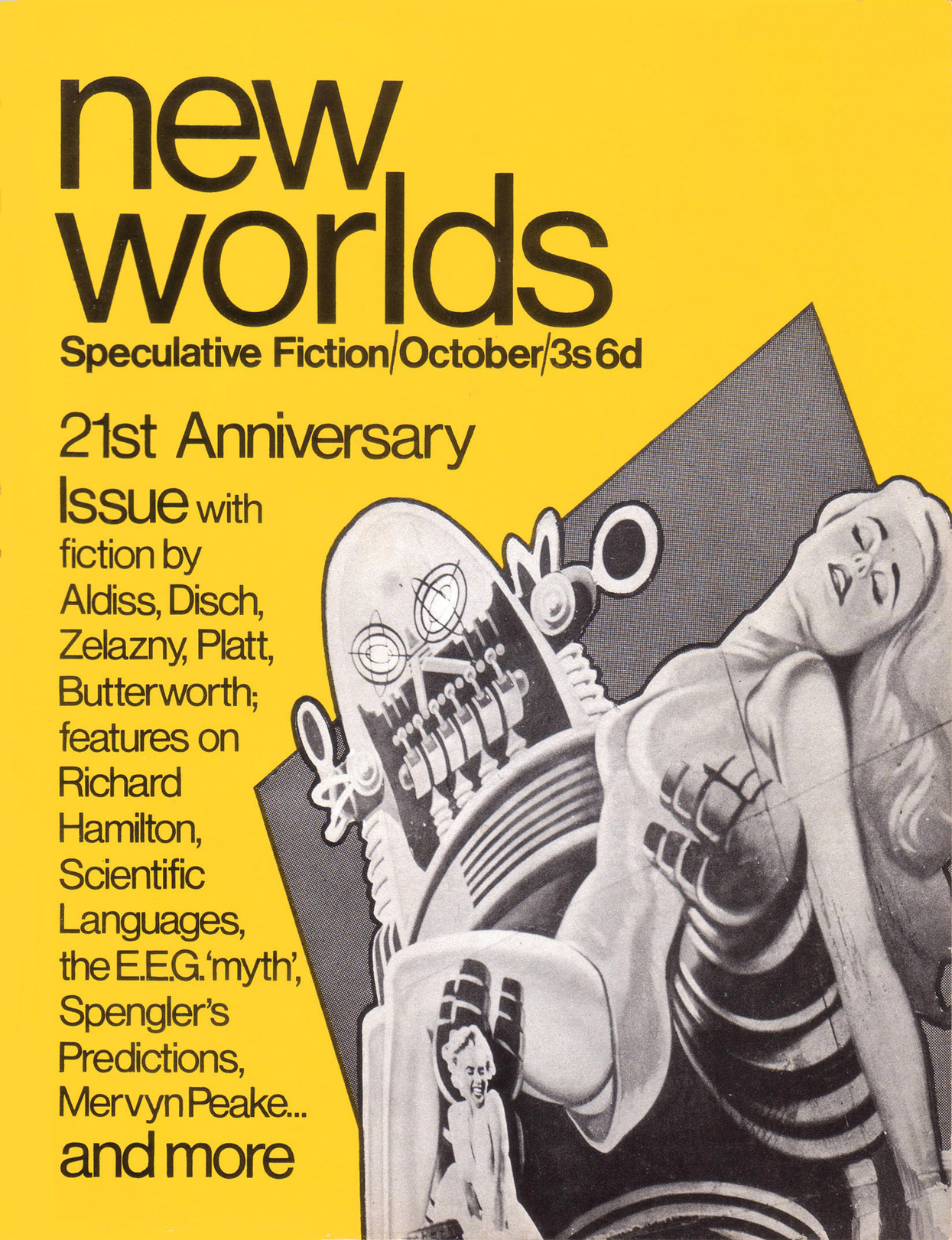
Under Moorcock’s editorship, the scope of New Worlds broadened to include writing on art—the work of Eduardo Paolozzi, who became credited as the magazine’s “aeronautics advisor,” was shown in it, and the October 1967 issue carried a piece on Richard Hamilton.[18] Science fiction had been a persistent interest of Independent Group members including Paolozzi and—perhaps most notably—Lawrence Alloway.[19] The kind of science fiction, if it was that, pursued by Ballard in the second half of the 1960s was, however, decisively different from the pop-culture interplanetary visions that had tended to excite the Independent Group, oriented as it was toward exploring what Ballard called “inner space,” the conditions of subjectivity within a technologically propelled and media-saturated consumer culture infused with violent and sexual imagery. This Ballard explored in a series of “condensed novels” that came to comprise his book The Atrocity Exhibition. In staging his show of crashed cars in 1970 at the Institute for Research in Art and Technology—both he and Banham were on its board of trustees—Ballard would enact a scene from The Atrocity Exhibition in the form of what he described as a “speculative illustration.” One of the three wrecks on show was, as Ballard described it, “a Pontiac from that last grand period of American automobile styling, around the mid-fifties. Huge flared tail-fins and a maximum of iconographic display.”[20]
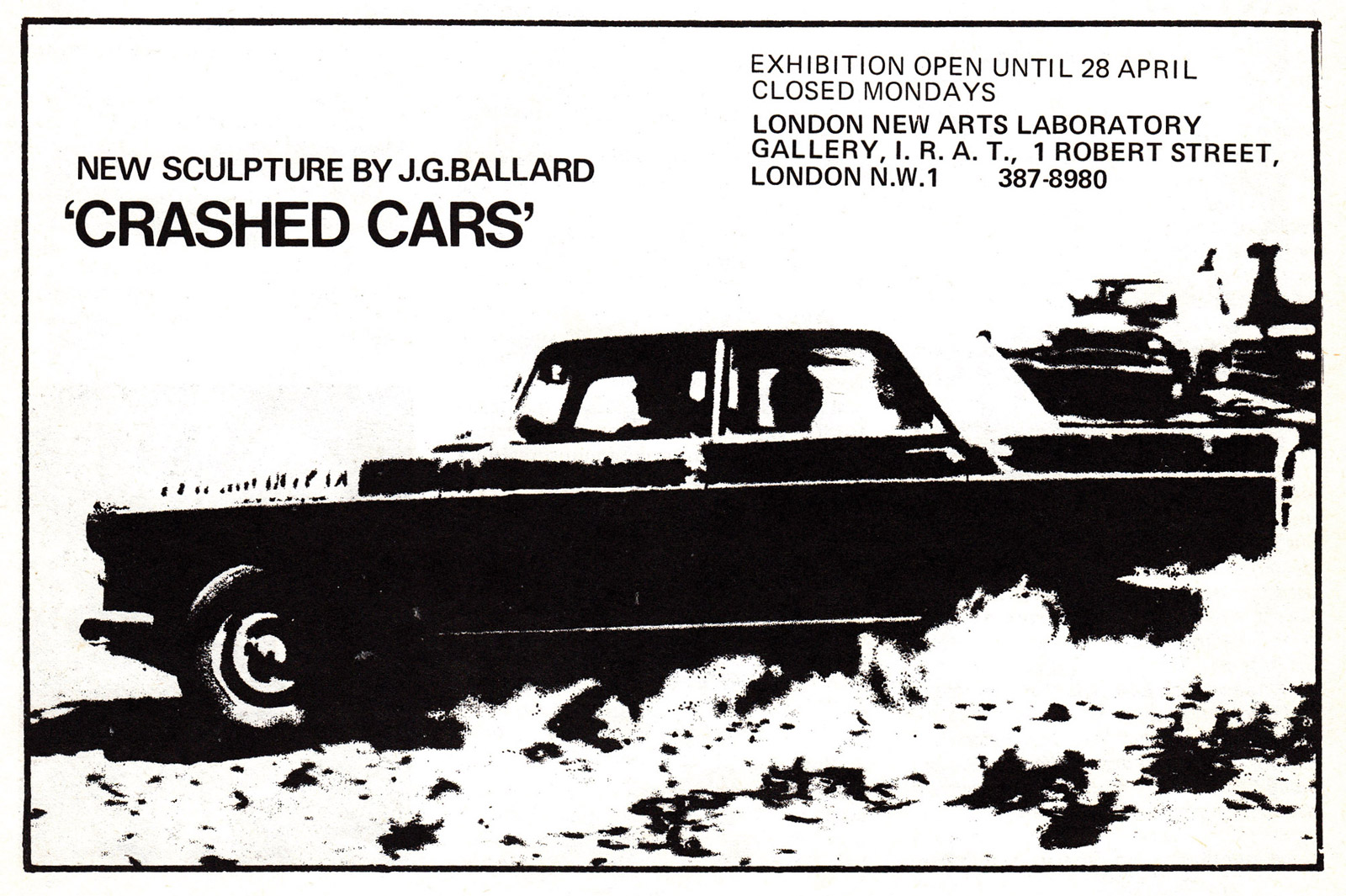
At this point, we can bring Ballard’s thinking into relation with some of the positions we have encountered. No doubt Ballard and Pevsner make strange bedfellows, but if we accept—and I think we can—that Pevsner’s charge of “outrageous stimulation” was a localized condemnation of broader tendencies, then there is a connection. For the diagnosis of “outrageous stimulation” was one that Ballard, in a strong sense, shared, although the consequences he drew were radically different. As he wrote in a later reflection: “A unique collision of private and public fantasy took place in the 1960s. ... The public dream of Hollywood for the first time merged with the private imagination of the hyper-stimulated 60s TV viewer.”[21] However for Ballard, the outcome of this was not some sort of constant escalation of experience—on the contrary “its finish line,” he wrote, “was that death of affect, the lack of feeling, which seemed inseparable from the communications landscape.”[22] Whereas Pevsner’s demand on the cusp of the 1960s was to rein in the new license and reassert prior controls, Ballard’s suggestion was instead to embrace existing conditions and pursue their possibilities. “Given the unlimited opportunities which the media landscape now offers to the wayward imagination,” he wrote, “I feel we should immerse ourselves in the most destructive element, ourselves, and swim.” The best we can hope for of the twentieth century, he continued, is “the attainment of a moral and just psychopathology.”[23]
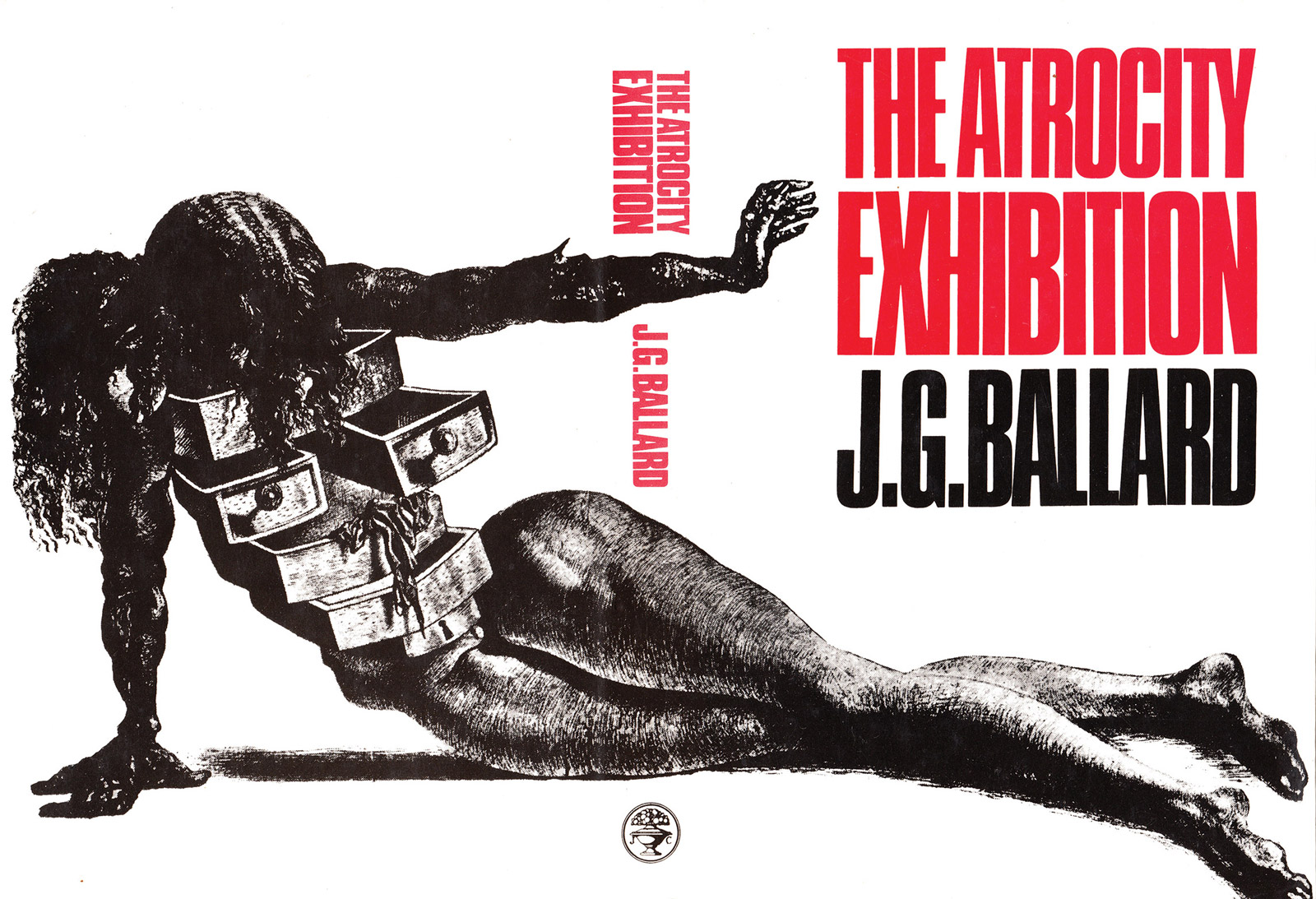
And here the issue of “styling” re-enters, for we find it to be deeply imbricated in Ballard’s thinking about the death of affect. Indeed, it almost comes to seem that around this issue Ballard stalked the Independent Group, re-enacting and recasting some of their key discursive and pictorial texts. In his “Vehicles of Desire” article, Banham had written that the top body stylists aim to confer “qualities of apparent speed, power, brutalism, luxury, snob appeal, exoticism and plain common-or-garden sex.”[24] It is hard to feel that Ballard was not channeling this when he came to describe the automobile as “an iconic entity that combines the elements of speed, power, dream and freedom within a highly stylised format that defuses any fears we may have of the inherent dangers of these violent and unstable machines.”[25] In Ballard’s version, however, “styling”—the phenomenon so effusively celebrated in Banham’s earlier text—now became problematized as the means by which design occludes the violence immanent to the device. Stylization and the death of affect turn out to be intimately related. The point is made clearer in another passage in which Ballard recalled his observation that “cruel and violent images which elicit pity one day have by the next afternoon been stylised into media emblems. ... The tragic photograph of the Saigon police chief shooting a Viet Cong suspect in the head was soon used by the London Sunday Times as a repeated logo keying its readers to Vietnam features in the paper. If I remember, the tilt of the dying man’s head was slightly exaggerated, like a stylised coke bottle or tail fin.”[26]
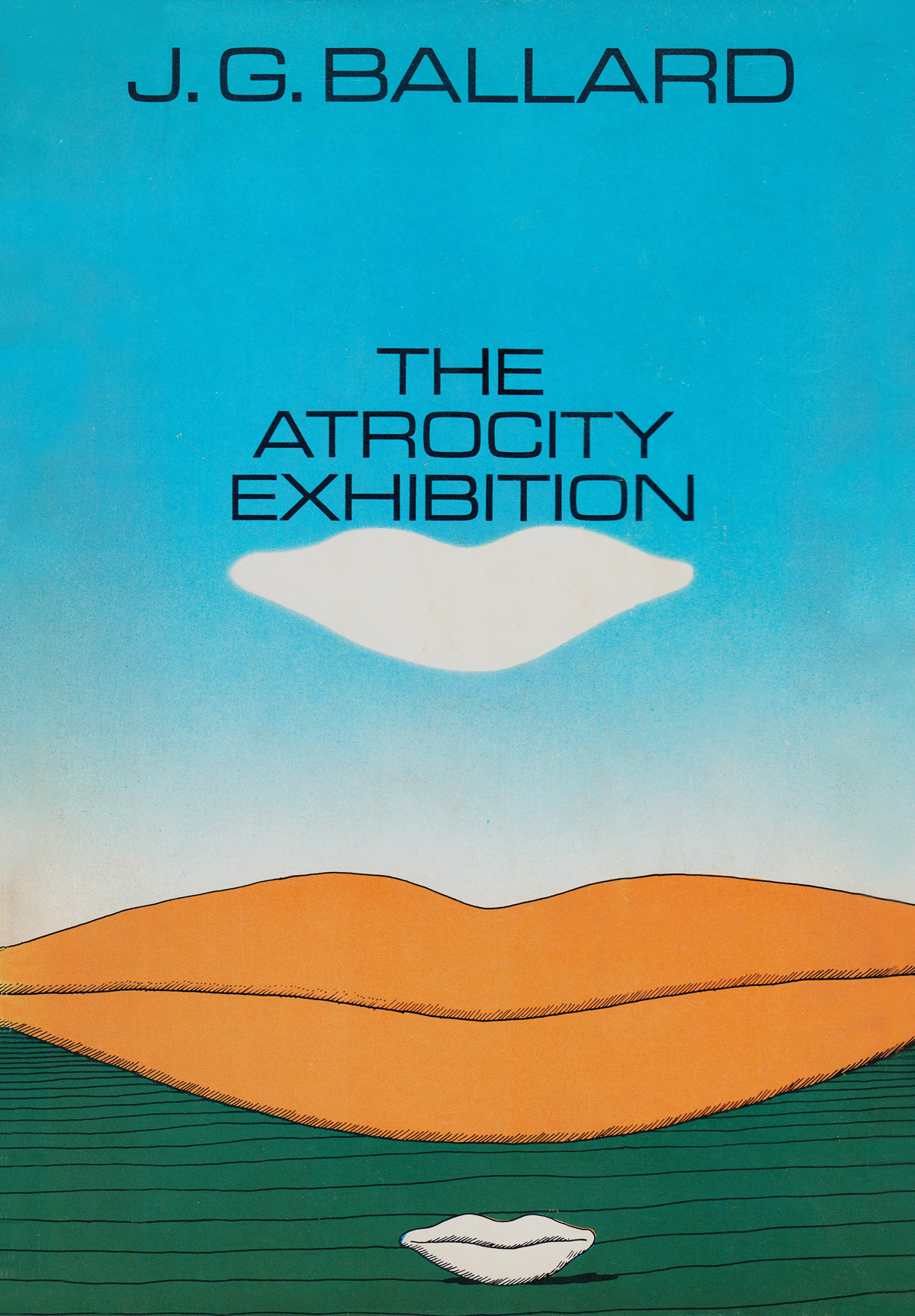
In a recent interview, Charles Platt—the future cryonics specialist who had handled graphic design at New Worlds under Moorcock’s editorship and had worked closely with Ballard—commented that “the media landscape creates an equivalence between the curve of a thigh and the contour of automobile sheet metal, and a car crash becomes a perverse erotic event.”[27] Let’s return to the scene of Richard Hamilton’s automobile paintings and set them alongside this description of an image from Ballard’s Crash: “Each of the spectators at the accident site would carry away an image of the violent transformation of this woman, of the complex of wounds that fused together her own sexuality and the hard technology of the automobile.”[28] While the paintings and the novel share a preoccupation with the merging of body and machine, in Hamilton’s case this was developed out of the corporeal mimetics of body styling of the kind Platt observes, which was already present in the consumer objects of the media age.[29] Ballard’s vision built upon this, but then reworked it through a violence that was in a sense directly enacted upon styling—or, better, was immanent to it, insofar as styling is understood as the dissimulation or occultation of violence. In this process, mimetic correspondence did not disappear but was displaced and refound in the violent fracturing of organic and machine bodies impelled by the force of impact that formed the new principle of conjugation. Here Hamilton’s array of points of attachment—Foster’s “charged details”—seemed to recur in the guise of the distribution of wounds that have erotically repatterned the body in a continuum with the machine.
Undoubtedly the death of affect—“the most sinister casualty of the century”[30]—was also welcomed by Ballard as a kind of liberation, with its counterpart, stylization, ushering in a postfunctional and thus postperverse future that he characterized as “lunar.”[31] Writing in the notes for his car crash exhibition, as they were rescripted in his ficto-autobiographical novel The Kindness of Women, he commented: “Across the communications landscape stride the spectres of sinister technologies and the dreams that money can buy. Thermonuclear weapons systems and soft-drink commercials co-exist in an uneasy realm ruled by advertising and pseudo-events, science and pornography. The death of feeling and emotion has at last left us to pursue our own psychopathologies as a game.”[32] Yet at the same time, this pursuit itself could evidently become a way of working back toward and recovering affect. If the “death of feeling” was to do with an ever greater alienation “from any kind of direct response to experience,”[33] then the violence he enthusiastically reported (or perhaps fantasized) that was provoked by his show of crashed cars seemed to push against this, even if—or especially because—it took place within the mediated space of the exhibition venue. A similar logic was in operation when Ballard lauded Paolozzi’s sculpture for its provision of an “ironic and imaginative replay of [a technological object] in which other people recognize their first perception of that object, that first blunted perception, heightened and illuminated.”[34]
If something animates and holds together the acts of violence in Ballard’s literature, it is perhaps the paranoiac fantasy that there is something that holds everything together, some hidden position, perspective, or arrangement that might be obtained from which the fragmented media-subject could gain coherence—from which, even momentarily, things would fall into place, appear significant, make sense, be solved, become “real,” and hence maybe also affective.[35] Such, at any rate, is the implication of The Atrocity Exhibition, where the compulsions of the name-shifting protagonist Travis/Travers/Traven/Tallis/Talbot/Talbert resolve—like the Warren Commission Report on the JFK assassination—into matters of geometry, trajectories and coincidences of space and time. These stitch together episodes as diverse as Talbert’s belief in the equivalence of all junctions and his related search for “the primary act of intercourse, the first apposition of the dimensions of time and space”; the imaginary refiguration of a lover’s body to produce an “obscene version” of it in the search for “a more significant geometry”; and Tallis’s apparent murder of Karen Novotny because she obscured the meeting of the wall planes in a room.[36] “Her figure interrupted the junction between the walls in the corner on his right,” Ballard writes. “After a few seconds her presence became an unbearable intrusion into the time geometry of the room. ... Coma sat down beside Karen Novotny’s body. She glanced at Tallis, who pointed to the corner. ‘She was standing in the angle between the walls.’”[37]
- See Nikolaus Pevsner, “The Return of Historicism,” in Pevsner: The Complete Broadcast Talks—Architecture and Art in Radio and Television, 1945–1977, ed. Stephen Games (Farnham, UK: Ashgate Publishing, 2014). Pevsner’s concerns are already evident in “Functional Architecture,” an earlier radio talk that was broadcast in New Zealand in 1958, also published in the same volume.
- Nikolaus Pevsner, “Modern Architecture and the Historian or the Return of Historicism,” RIBA Journal, vol. 68, no. 6 (April 1961), p. 235.
- The historian’s bête noire here was a project by Michael Webb—later of Archigram but then a student in the school of architecture at Regent Street Polytechnic in London—for a building for a furniture manufacturers’ association. Claiming this design “out-Gaudíed Gaudí,” Pevsner went on to describe it on the radio as “abstract sculpture of a doughy, rooty, bony, or gristly kind.” See Nikolaus Pevsner, “The Return of Historicism,” p. 414, and “Modern Architecture and the Historian,” p. 231. Webb’s project, completed when he was a fourth-year student, had been on view as part of Arthur Drexler’s “Visionary Architecture” exhibition at MoMA shortly before Pevsner’s Royal Institute of British Architects address.
- Nikolaus Pevsner, “Modern Architecture and the Historian,” p. 237.
- Hal Foster, “Notes on the First Pop Age,” in Richard Hamilton, ed. Hal Foster with Alex Bacon, October Files, no. 10 (Cambridge, MA: The MIT Press, 2010), p. 46.
- “Borax, or the Thousand Horse-Power Mink” (4 March) and “Metal in Motion—The Iconography of the Automobile” (7 July). See Graham Whitham, “Chronology,” in The Independent Group: Postwar Britain and the Aesthetics of Plenty, ed. David Robbins (Cambridge, MA: The MIT Press, 1990), pp. 30–31. Hamilton’s exhibition had in fact debuted at Newcastle University’s Hatton Gallery earlier that same year.
- Reyner Banham, “Vehicles of Desire,” in A Critic Writes: Essays by Reyner Banham (Berkeley: University of California Press, 1996), p. 4. The essay was first published in Art, no. 1 (September 1955).
- Ibid., p. 5
- Richard Hamilton, “Persuading Image,” in Collected Words, 1953–1982 (London: Thames and Hudson, 1982), p. 142. The lecture was delivered in 1959 under the title “The Designed Image of the Fifties.”
- Richard Hamilton, “An Exposition of $he,” in Collected Words, p. 36.
- Hal Foster, “Notes on the First Pop Age,” p. 54.
- Ibid., p. 61.
- See, for example, Roger Luckhurst, “Ballard / Atrocity / Conner / Exhibition / Assemblage,” in J. G. Ballard: Visions and Revisions, ed. Jeannette Baxter and Rowland Wymer (Basingstoke, UK: Palgrave Macmillan, 2012), p. 36.
- “1971: Frank Whitford. Speculative Illustrations: Eduardo Paolozzi in Conversation with J.G. Ballard,” in Extreme Metaphors: Selected Interviews with J.G. Ballard, 1967–2008, ed. Simon Sellars and Dan O’Hara (London: Fourth Estate, 2012), p. 43. The interview was first published in Studio International, vol. 182, no. 937 (October 1971).
- Michael Moorcock, “Editorial: A New Literature for the Space Age,” New Worlds, vol. 48, no. 142 (May–June 1964), p. 2. See also Rob Latham, “Assassination Weapons: The Visual Culture of New Wave Science Fiction,” in Cutting Across Media: Appropriation Art, Interventionist Collage and Copyright Law, ed. Kembrew McLeod and Rudolf Kuenzli (Durham, NC: Duke University Press, 2011).
- Michael Moorcock, “Editorial,” p. 3.
- J. G. Ballard, “Myth Maker of the Twentieth Century,” in A User’s Guide to the Millennium: Essays and Reviews (London: Flamingo, 1997), p. 130.
- See David Brittain’s wide-ranging study Eduardo Paolozzi at New Worlds: Science Fiction and Art in the Sixties (Manchester: Savoy Books, 2013).
- See Rebecca Peabody, “Science Fiction as Muse: Lawrence Alloway and the Art of Speculative Criticism,” in Lawrence Alloway: Critic and Curator, ed. Lucy Bradnock, Courtney J. Martin, and Rebecca Peabody (Los Angeles: Getty Research Institute, 2015). In 1954, Alloway became the co-convener of the Independent Group with John McHale.
- “Speculative Illustrations,” p. 40.
- J. G. Ballard, The Atrocity Exhibition, with Author’s Annotations (San Francisco: Re/Search Publications, 1990), p. 16.
- Ibid., p. 72.
- Ibid., p. 20.
- Reyner Banham, “Vehicles of Desire,” p. 6.
- J. G. Ballard, The Atrocity Exhibition, p. 97.
- Ibid., p. 21.
- Pedro Marques, “The Once New Worlds of Charles Platt.” Available at pedromarquesdg.wordpress.com/2011/11/02/the-new-worlds-of-charles-platt. Platt’s work includes the celebrated illustrations for Ballard’s condensed novel “The Summer Cannibals,” published in New Worlds, no. 186 (January 1969).
- J. G. Ballard, Crash (London: Vintage, 1995), p. 189.
- For Vaughan in Crash, “the smallest styling details contained an organic life as meaningful as the limbs and sense organs of the human beings who drove these vehicles.” See J. G. Ballard, Crash, p. 169.
- J. G. Ballard, “The Innocent as Paranoid,” in A User’s Guide, p. 91.
- Ibid. Ballard’s interviews shed light on his thinking around these issues. Two examples: “Nothing is spontaneous, everything is stylised, including human behaviour. And once you move into this area in which everything is stylised, including sexuality, you’re leaving behind any kind of moral or functional relevance,” and “The psychological landscape is going to be somewhat like the physical landscape of the moon. ... Does that appeal to me? Yes it does, because I think people will have more freedom there, I mean the freedom of isolation, the freedom of complete choice in one’s behaviour. ... I think one’s moving into a realm where everything will become increasingly stylised.” See “1970: Lynn Barber. Sci-fi Seer” and “1974: Carol Orr. How to Face Doomsday without Really Trying,” in Extreme Metaphors, p. 34 and pp. 69–70, respectively.
- J. G. Ballard, The Kindness of Women (London: Flamingo, 1994), p. 226. For a transcription of the original text, see Simon Ford, “A Psychopathic Hymn: J. G. Ballard’s ‘Crashed Cars’ Exhibition of 1970.” Available at www.slashseconds.org/issues/001/001/articles/13_sford/index.php.
- “Speculative Illustrations,” p. 164.
- Ibid., p. 165.
- Something like this is enacted in the bedroom scene at the end of The Kindness of Women when Cleo shuts away the multiple mirror reflections. See pp. 322–323.
- J. G. Ballard, The Atrocity Exhibition, pp. 56, 60, 42.
- Ibid., p. 42.
Mark Dorrian holds the Forbes Chair in Architecture at Edinburgh College of Art, University of Edinburgh. His books include Writing on the Image: Architecture, the City, and the Politics of Representation (I. B. Tauris, 2015) and the co-edited Seeing From Above: The Aerial View in Visual Culture (I. B. Tauris, 2013). He is currently working on the cultural history of sketches and sketchbooks.
Spotted an error? Email us at corrections at cabinetmagazine dot org.
If you’ve enjoyed the free articles that we offer on our site, please consider subscribing to our nonprofit magazine. You get twelve online issues and unlimited access to all our archives.